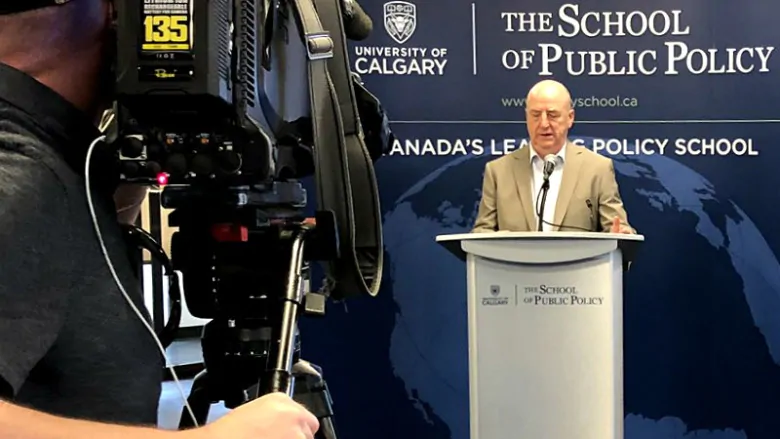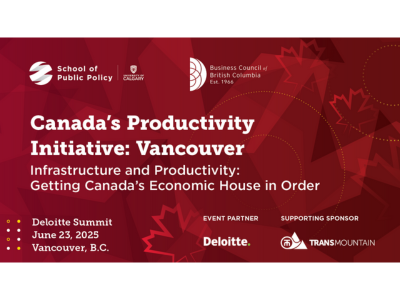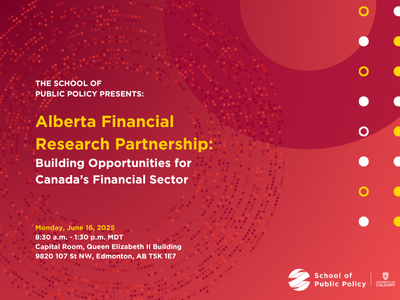Why this economist says equalization reform isn’t the answer if Alberta wants help during its busts

University of Calgary economist Bev Dahlby speaks to reporters about his proposal for reforming Canada's fiscal stabilization program. (photo by Dana Fenech, School of Public Policy)
Many Albertans have long complained that Canada’s equalization system isn’t there for them when their province goes through an economic bust.
But a University of Calgary economist says calls for reform should be focused, instead, on a lesser known federal program of wealth distribution.
“What Albertans should really complain about is the fiscal stabilization program, which is meant to be a form of insurance for provinces whose economies experience economic shocks,” School of Public Policy research director Bev Dahlby writes in a policy paper released Wednesday.
“In reality, it is an insurance policy that has been designed so that it barely pays anything to Alberta.”
Alberta received about $250 million from the program in 2016, but Dahlby is calling for the system to be changed in a manner that would have seen the province receive roughly 10 times that amount.
How the stabilization program works now
Under the current rules, a province can apply for financial assistance if its non-resource revenues decline by more than five per cent from one year to the next.
Payments are also capped based on population, with a maximum of $60 per person.
And assistance is not automatic; it must be approved on a case-by-case basis by the federal government.
This also prevents abuse of the system, which Ottawa says is meant to apply only in what it deems to be “extraordinary” economic situations.
“The program compensates for year-over-year revenue declines due to economic downturns, not for declines due to provincial decisions to reduce taxes,” the Department of Finance specifically states.
In other words, provinces can’t sabotage their own finances — say, by slashing taxes one year to sink their revenues enough to qualify for assistance — and then simply expect the federal program to make up the difference.
Dahlby is calling for major reforms to the eligibility criteria and a different way of avoiding abuse.
Preventing ‘fiscal arson’
For starters, he wants to see the $60-per-person cap removed and resource revenues included in the eligibility criteria.
Instead of making year-to-year financial comparisons, he also suggests contrasting a given fiscal year against the previous, five-year average.
He also wants a funding formula to be established so that assistance is automatic, rather than based on an application process. This would “streamline” the process, speed up payments and avoid political controversy, he says.
The fiscal stabilization program should be reformed to ensure that it actually provides adequate levels of insurance to the resource-dependent provinces – Bev Dahlby
Automatic assistance would also create the need for different safeguards against “fiscal arson,” he admits. But he says this could be accomplished by effectively setting “deductibles” and limiting coverage in such a way that would dissuade a province from “burning down its home to collect insurance.”
He proposes three possible methods to do this.
Method A (the least generous of his proposals) would include a five-per-cent “deductible” and a 50-per-cent coverage rate for losses beyond that deductible.
“In other words,” Dahlby writes, “only reductions in annual own-source revenues in excess of five per cent of the average own-source revenue over the previous five years would be eligible for a payment and only 50 per cent of that would be covered.”
Method B would also include a five-per-cent deductible, but with a 75-per-cent coverage rate.
And Method C would have a lower deductible — just three per cent — along with a lower coverage rate of 66 per cent.
How would these changes affect Alberta?
Dahlby calculates these methods would have resulted in much more financial support for Alberta during its recent economic downturn.
Remember: the province received roughly $250 million under the current fiscal stabilization program in 2016.
Under Dahlby’s proposals, Alberta would have received $2.1 billion under Method A, $3.1 billion under Method B or $3.2 billion under Method C.
The following year, it would have received even more: between $2.8 billion and $4.2 billion, depending on the calculation method.
Provinces like Saskatchewan and Newfoundland and Labrador, which also experience booms and busts related to the prices of oil and gas, would also receive more federal funds during downturns under this approach, Dahlby notes.
He suggests such a system would be a more effective “insurance policy” for provinces that rely heavily on volatile natural-resource markets and, as such, their lobbying efforts would be better directed at reforming the stabilization program than Canada’s system of equalization payments.
“While it is true that the equalization program needs reform, that program was never meant to help a province such as Alberta, where GDP per capita and household incomes are above the national average, even in times when its economy shrinks,” he writes.
“Alberta and the other resource-rich provinces should also pressure the federal government to reform the fiscal stabilization program in order to address their concerns about the lack of federal support in the wake of the downturn in the oil and gas sector.”
Dahlby also sits on the expert panel appointed by Premier Jason Kenney that is tasked with offering advice to the Alberta government on how to balance its budget without raising taxes.
Source: Calgary Herald


